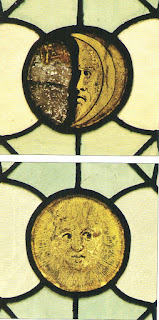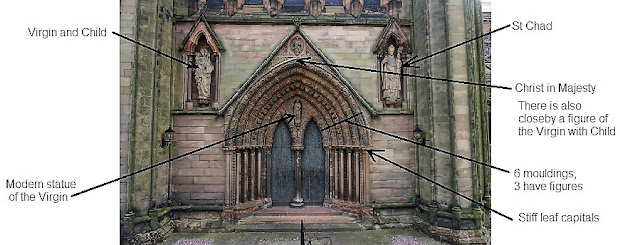The south transept was built with an ‘Early English’ style of architecture. It had simplicity, external buttresses, pointed arches and the south face had a five-light window with an innovative wheel window above. Licences to obtain stone and wood, overseen by King Henry III, help to date this part of the cathedral to a construction around 1220.[1] The master-mason was Thomas the Elder. The north transept differs architecturally in many ways[2] and its date has been fixed as ‘Late Early English’ with construction c. 1240. Wall shafts under the vault in the south transept have on their top an Early English abacus[3] and above that a later abacus in Perpendicular style suggesting the stone vault roof was added considerably later than when the lower walls were built.[4],[5] Indeed, some have suggested the transept may have had an initial wooden roof.[6] In 1221, the king gave the chapter twenty oaks from Cannock Forest, perhaps, intended for the roof trusses, or more likely the necessary scaffolding.[7]
View of
South Transept interior.
Shaft capital in the north east corner showing an Early English abacus below a Perpendicular abacus. Suggests a change in style from wall to roof or perhaps a change of roof.
Plan of South Transept; internally, c. 15.5 m (51 feet) long and c. 14 m (45 feet) wide. It is three bays long.
The south transept suffered much damage in the Civil War with the middle spire falling towards it. One loss was a series of wooden tablets on the west wall inscribed with the names of the kings of Mercia and the bishops of Lichfield. Fortunately, the listing was copied in 1569 and the copy confirms much about the history of the cathedral.
By1665, Bishop Hacket wrote the roof had been repaired and leaded after the Civil War. In 1758, 1796 and again in 1892, the wheel window high up on the south side was restored.
Wheel window from the inside. It has 12 radiating spikes and is 17th-century. It is not a Rose window.
In 1795, Wyatt had to strengthen the buttresses. In
1819, the Great Window[8]
had John Betton and David Evan’s depiction of 18 figures from the Old and New
Testament, but this was replaced in 1895 by Charles E. Kempe’s ‘Spread of the
Christian Church’. Some of Betton and Evan’s glass is now in the transept’s
east clerestory windows. In the 1960s, the rafters were found to be infected
with the death watch beetle larvae and damaged wood had to be removed. The west
side of the transept was repaired in 1964.
South
transept showing the Great Window and the round window.
In Medieval times pilgrims and penitents entered the
cathedral through the south transept door. Two chapels had been added to the
east side of the transept with priests ready to offer prayers for the dying and
the dead.[9]
South Transept door. Statues from left to right, Augustine of Hippo, Jerome from Croatia, Ambrose of Milan, Gregory the Great from Rome, John Chrysostom of Constantinople, Athanasius of Alexandria, Basil of Caesarea. These statues have a Roman cement casing.

Regimental
Standards hang over the south wall.
Date
of the roof conjecture
Willis1 stated, ‘the
transepts of Lichfield now have stone vaults considerably later than the
walls.’ This has led to much speculation (see note 4 and 5), including whether
there was a timber roof originally and later replaced with a stone, vaulted
roof. This idea of a timber roof replaced with a stone roof occurs again with
the nave, but there is no strong evidence for this anywhere in the cathedral;
it is a subject that invites conjecture. There are tierceron vault ribs in the
stone roof and this has been thought to show a date later than the c. 1220
for the south transept. However, such a roof exists above Lincoln’s nave with a
date of c. 1235. This also fits in with the remodelling of the
choir and a roof possibly added at this time. Since adding a roof requires a
very tall, timber, scaffold frame to hold a centring frame around which the
stone is rested before all voussoirs of the arch are in place, it is logical
several roofs are completed in a sequence. An explanation could be the roofing
of the middle part of the cathedral was undertaken concurrently and all was
late Early English or very early Decorated.
The bosses
in the south transept roof look perpendicular in style and show that the roof
was altered in the 15th-century. The small boss in the middle of the photo is
different from the others.
[1]
R. Willis, 'On foundations
of early buildings recently discovered in Lichfield Cathedral'. The
Archaeological Journal, (1861), 18, 1–24. York Minster south transept was constructed 1230–41
and Willis thought the two buildings had a correspondence in their dating.
Masons marks on the stonework of the west front were found to replicate, with
one exception, those on the south transept. From this Rodwell thought there was
an earlier west front (1220–30), but there could be later work on the south
transept, c. 1300; see W. Rodwell, Dating the west front. Unpub.
paper in Cathedral Library (1989), 4. A. B. Clifton, The Cathedral church of Lichfield. (London: 1900) quotes a date of 1230-1241 without reference.
[2]
For example, the aisle is much larger that the one in the south transept. The two
doorways and associated statues are very different. These differences between
the transepts are exaggerated by differences between the bays. See M. Thurlby,
'The Early Gothic Transepts of Lichfield Cathedral'. in Medieval
Archaeology and Architecture at Lichfield, J. Maddison (ed.), 1993,
50-64.
[3]
A large, flat slab above the capital on the top of the wall shaft which
supports the arch.
[4]
The later roof is said to have been instigated by Bishop Walter Langton. See J.
Britton, The history and antiquities of the
See and cathedral church of Lichfield. (London: 1820), 28. It could have also been undertaken in the 1350s, see
note 5.
[5]
The position of the south round wheel window between the lower stone vaulted
roof and the upper external roof, so that it cannot be seen from inside the
cathedral, has been said to be proof for the stone roof added later. See, J. C.
Woodhouse, A short account of Lichfield
Cathedral. Lichfield: (Lichfield:
1811), 5. Furthermore, the wheel window is said to have features from the
Decorated period.
[6]
Willis (1861), 18.
[7]
M. W. Greenslade and R. B. Pugh, 'House of secular canons - Lichfield
cathedral: To the Reformation', in A History of the County of Stafford:
Volume 3, (London, 1970), 140-166.
[8]
Now a nine-light window.
[9] Willis (1861), 11, presumed the transepts originally had east facing chapels on their eastern walls, but there is no documentary evidence. Rodwell had also assumed round chapels off the second cathedral choir, but no firm archaeological discovery has supported this. These are assumptions based on arrangements found elsewhere, such as at Leominster.



















